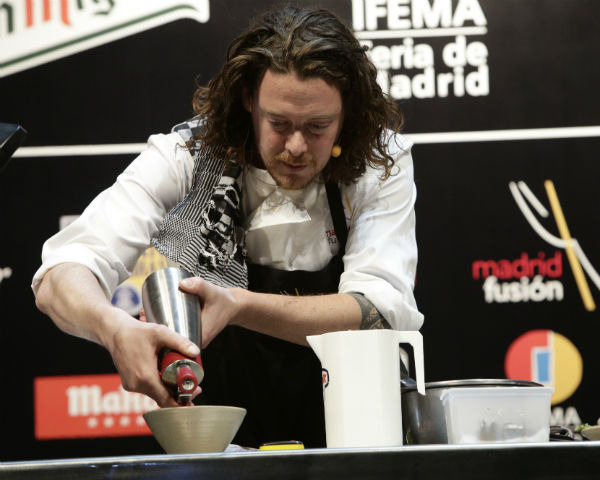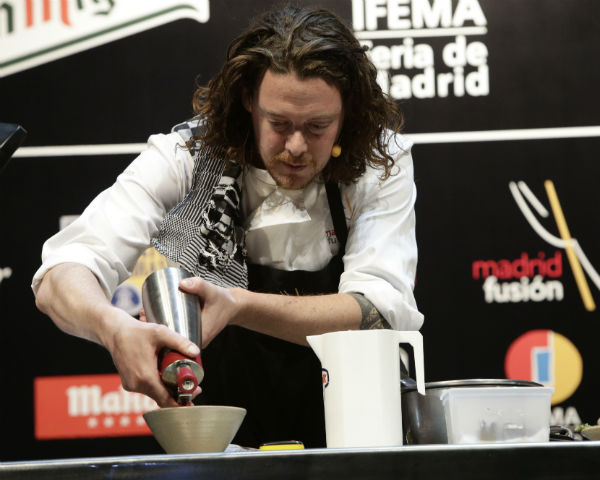Madrid Fusión Day 2: Star Chefs? Yes And No
Perhaps because he's had a peripatetic career, Jean Luc Figueras isn't very well-known outside Spain, but since the days when he cooked at the lamented Eldorado Petit in Barcelona through his comings and goings at a wide range of other establishments, he has remained one of the best chefs in what might be called the modernized-traditional style. He was on stage at Madrid Fusión first thing this morning, in the auditorium at the city's Palacio Municipal de Congresos, with Alain Guiard and Óscar Escanciano of Babette Catering, a firm based in Sant Cugat del Vallés, next door to Barcelona, that took first place in last year's World Catering Championships in Lyon. Figueras, who helped his colleagues demonstrate one of the winning dishes — sea bass tartare with chorizo gelatin and caramelized orange peel — was there because he had worked with them temporarily in preparing for the competition.
See Madrid Fusión Day 1, Madrid Fusión Day 3
After he came off stage, Figueras told me that late last year he had opened a place in the new Mercer Hotel in Barcelona, called Mercer Restaurant Jean Luc Figueras. Here, he's serving the kind of updated French-accented Catalan food he's known for (chicken and chestnut cream soup with foie gras and coxcomb "popcorn," oyster and pig's foot ravioli with sultana polenta, sea bass with salt cod tripe and blood sausage, and such).
Elena Arzak gave a demonstration in her usual style — calm, lucid, technically impressive — this time focusing on those trendy new ingredients salt and pepper. Quique Dacosta, whose eponymous restaurant in Dénia, in the Alicante region, won its third Michelin star last year, fielded a team of six cooks working at five tables to turn out almost 20 little bites in 20 minutes' time — he kept watching the countdown clock ("We have 55 seconds left, work quickly!") — including tuna belly atop tiger-nut milk solidified in gelatin, with shallots and Korean red pepper paste on top; strawberry turrón (the famous nougat of Alicante) with vinegar; cones of oven-dried pasta filled with wild basil mousse; blue cheese and rosemary blossoms wrapped in rice dough; warm olive oil ice cream (a dish Dacosta first presented at last year's Madrid Fusión) topped with shards of black truffle–potato waffle cone and caramelized chicken reduction; a marinated monkfish and smoked butter "taco" made with coca (flatbread) dough instead of tortillas; and a "meat" dish consisting of several immense garrofó beans (think butter beans on steroids) in rabbit and thyme sauce.[pullquote:left]
Madrid Fusión has guest countries every year, whose cuisine and products are spotlighted. This year, there are several — Flanders (not a country per se, but the Dutch-speaking portion of Belgium) and the Andean nations of Peru, Chile, and Bolivia. Flemish chef Kobe Desramaults (below), who runs the small In de Wulf in Dranouter, on the French border in western Belgium, continued the conference's stated theme of "Eating in the city" by, er, talking about his small family farm, the fields and forests he forages in, and the five neighboring farms he buys from. He demonstrated his take on a traditional Flemish dish of potatoes puréed with buttermilk and white cheese, topped with freshly grated horseradish and with young garlic shoots, field cress, and sorrel, which he proudly announced he had picked that morning from Madrid's vast El Retiro park — probably illegal, but admirable.
Flemish chef Kobe Desramaults
The legendary French chef Michel Bras — another decidedly non-urban culinary creator — didn't do a demo but sat for an on-stage interview by the noted Spanish food writers Víctor de la Serna and Borja Beneyto. Bras is diminuative in stature and modest in his assessment of his own achievements. "All I did," he said, "was to start putting the vegetable garden in its proper place in cuisine." He went on, "What is most important, what I'm proudest of, is that for me, being a chef is not a business. It's a way to write my history. It's my music, my painting. My cuisine is my life." He bemoaned the fact that to be taken seriously as a chef today, "one has to provoke and surprise." After making clear that his success is not his alone, but must be shared with his wife — "My story is not the story of Michel, but the story of Michel and Jeannette" — he advised younger chefs not to "torture your brains" looking for something new all the time, adding "Technique should be at the service of cuisine, not the other way around." When de la Serna asked Bras his opinion of "star chefs, top chefs, cuisine as media phenomenon," he answered, "There are good things and bad things. It's good because the chef's trade is becoming well-known. It's bad because people start to think that cooking is being a show, a program. Star chefs? Yes and no."
Taking a break from the auditorium sessions, I walked around the exhibition floor with José Andrés. This was something of a frustrating experience, because he seemed to know every single person we passed (or they knew him, or wanted to), so a distance of 50 yards took half an hour; along the way, though, he did tell me that he is opening a Chinese–Peruvian restaurant next to Jaleo in August, to be called China Chilcano — a play on China Poblano, his Chinese-Mexican place in Las Vegas (a chilcano is a pisco-based Peruvian cocktail). The reborn America Eats Tavern, meanwhile, is scheduled for to debut on May 5 — which of course is that old American holiday known as Cinco de Mayo. Andrés also revealed that he had recently supplied some top-quality jamón ibérico to Ron Cooper of Del Maguey artisanal mezcal. Inspired by the traditional Oaxacan mezcal in which a raw chicken or turkey breast is macerated, Cooper is going to try the same trick with the ham.
Back in the auditorium, Joan Roca was showing the audience his variations on some traditional Catalan fish dishes: His suquet, typically a rustic stew of potatoes and monkfish or some other variety, became red mullet lightly cooked sous-vide, with daubs of potato purée. Sole with garlic and parsley was rethought as two sole filets vacuum packed together so that they fuse into one, sauced with stripes of white garlic and lemon allioli, fermented black garlic paste, and parsley purée. Strips of razor clams cooked sous-vide and espardenyes (sea slugs) quickly stir-fried were draped over the spines of a metal sculpture of a sea anemone, then moistened with an emulsion of puréed sea anemone and olive oil. "It is so easy to use olive oil to make an emulsion with almost anything," he said.
When Roca left the stage, a video about a new app for restaurateurs was screened. Created by the Valencia Chamber of Commerce, foodly.com lets those in the food service trade search all reviews and comments, amateur and professional, that have appeared about their establishments or those of their competitors. Roca, Quique Dacosta, and Andoni Luis Aduriz have all offered testimonials for the app, which is said to now have some 700 restaurateurs signed up.
Walking around the exhibition floor at some point, I ran into Dani Garcia, who opened Manzanilla in midtown Manhattan last year. I asked him how it was going. "It's going," he said, "but it's hard." He elaborated later, in a session called Businesses Abroad: Opportunity and Profitability. This brought together Garcia and three other Spanish chefs who have opened restaurants in other countries — Sergi Arola (now represented in Paris, Santiago de Chile, São Paulo, Hong Kong, and Mumbai, among other cities), Martín Berasategui (who has places in Shanghai, Mexico City, and Punta Cana), and Marcos Moran (of Hispania in London). After Arola noted that he had deals with the Ritz-Carlton and Marriott chains, among others ("I always try to ally myself with five-star American brands, because they're very serious"), Garcia revealed that he felt a conflict between his emotional side, which wanted to be 100 percent Spanish, and his practical side, which told him that he had to give people what they understood. "You need a balance," he said. "You must not prostitute yourself, of course, but you have to serve people what they want. It's another culture in America. You have to adapt yourself. I can get sardines in New York, but they're frozen, so I don't serve sardines."
Read more stories from Madrid Fusión:
Madrid Fusión Day 1: Cactus Pears and Salt Cod Tripe

